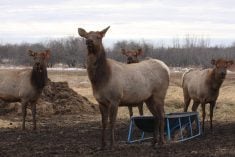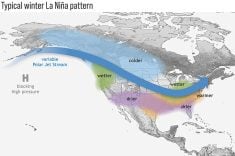Time and energy are consumed every time farmers transfer commodities like seed or granular fertilizer from one vessel to another.
It’s no big deal in the yard because the tender truck can be turned around and returned to the field on time before the air cart runs dry.
But when a half-million dollar seeding rig is standing still in the field getting topped up, fill time suddenly becomes an issue.
Bigger drills require bigger carts. And bigger carts require longer fill times, especially with today’s need for multiple products.
Read Also

Canadian Food Inspection Agency extends chronic wasting disease control program consultation deadline
Date extended for consultation period of changes to CWD program
To meet that challenge, could a 100-foot drill be fed directly from a pair of hopper bottom trailers working in rotation?
While one trailer is plugged into the drill, feeding seed and fertilizer on the go, the other trailer is back in the yard being filled.
In essence, the tender trailers turn double duty and become product carts.
Not unlike a large single product cart like the Seedmaster Titan III, this solution uses a large, unpressurized cart but with multiple products and a self-contained air system.
It would have as many as five compartments and total capacity up to 1,200 bushels and remain roadworthy and legal.
Due to the large volume of product in each trailer, there would be time to rotate carts, even over long distances from a home yard where both machinery and labour are easily available.
Fast cart replacement times are critical to the concept.
Tires vs. tracks
With normal tires and axles, a 1,200-bu. trailer carries more weight than the law allows on public roads. But there are ways to make it legal at full capacity and function in the field, said Kevin Anderson, a farm machinery designer with Horsch Anderson in Andover, South Dakota.
The addition of an extra tridem axle can legalize the load.
Tires with a bigger footprint, such as super singles or agricultural flotation tires, can help legalize the load on the road and help the trailer stay on the surface in the field.
“Weight saving really is the biggest factor,” said Paul Gray of OK Tire in Fargo, North Dakota. OK Tire sells the Michelin X-One super single.
“The X-One has become very popular here in sugar beet country. But there’s more to it than just the weight. The trailer pulls a lot easier. I’d say nearly all the sugar beet trailers are on super singles, either our X-One or the Bridgestone Greatec.”
If staying with inflatable round rubber tires, central tire inflation would probably be needed to make the whole thing work in soft spring fields, either with tridem, super singles or flotation tires.
The downside with flotation tires is that the trailer would need extensive modifications to make them fit and it might not remain highway compatible.
Another solution is rubber tracks. Rubber tracks may limit transit speed but in a system like this, there should be time to get to the most distant farmyard and back between fills.
Ten years ago, some producers created their own systems by modifying the rear axle assembly on a highway trailer.
The distance between the centrelines of the two trailer axles is almost a match for some of the rubber tracks manufactured for farm tractors at that time.
The complexity of the project ranged from simple to difficult. Some producers found they could simply deflate the trailer tires, slip on a used rubber belt and re-inflate the tires, holding the tracks in place.
Some producers chose to build hubs and bogies to support recycled tractor belts.
Today, farmers can pick from a long list of competing companies that have developed complete rubber track systems for farm implements. It’s largely a matter of deciding on the specifications and writing the cheques.
Dave Simoneau of Soucy International said his company is delivering track systems for grain carts, combines, tractors and military vehicles that offer low wear and high speed compatibility.
“Wetter conditions in Western Canada has meant more farmers are seeing a need to support large loads in the field and on the road. Tracks are taking hold on the Prairies,” he said.
Some European field tractors, such as Fendt and Claas, are available with a fifth wheel option for pulling highway trailers in and out of muddy fields. Some are capable of high road speeds, offering another solution to loading and transporting trailer carts.
If the seed trailers serve double duty hauling commodities with tires in their off-season, sizing a track solution to other farm machinery might be an efficient way to make use of them during the rest of the year.
The five-minute challenge
Anderson said farmers would need to swap carts quickly to be efficient. One person needs to disconnect hydraulic connections, air connections and electrical connections between the drill and the empty trailer.
A standard semi-tractor fifth-wheel hitch works for the road and the field.
Trailers could be dollied down and swapped with the aid of a powered winch.
If extra weight is needed on the drill, the fifth wheel can mount directly on the drill frame. A drawback to this direct mount is the increased odds of jackknifing with so little distance between drill and trailer.
A converter dolly between the drill and trailer using a floating hitch at the drill connection would provide support and space between implements. Rubber tracks could support the converter dolly.
Fans can be mounted on the drill frame with large diameter air pipes running back across the top of the trailers.
The other option is to run hydraulic lines to the rear of the trailer and mount the fans at the back to give the operator precise control of the fans.
Either way, the air flows forward along the underside of the hoppers, picking up the right amount of product from each of the hopper bottoms.
With five compartments of 240 bu. each, the producer has a number of options in designing blends on the go. The shape of the hoppers should provide enough slope that the compartments do not need to be pressurized.
At the bottom of each hopper bottom is a metering box attached by four bolts. The box is removed when the trailer goes back to straight highway hauling.
Each box is fitted with a Norac metering system similar to that employed on Horsch Anderson air carts.
The rollers are driven by an electric motor controlled by digital signals from the controller. This results in precise metering to the highest volumes of granular nitrogen from the lowest rates of canola seed.
Rollers are available for small grains, pulses, oilseeds, soybeans, corn, inoculants and all types of granular fertilizer. Changing rollers takes only a few minutes.
Running from back to front, two pneumatic lines receive product from these five metering motors. The big line carries the bulk of the fertilizer blend while the smaller line carries a blend of seed and starter fertilizer.
When the lines reach the drill, it’s back to business as usual.
Roll on and roll off
Anderson, who designed and built the Horsch Anderson seeding system, has been at the leading edge of air cart development for more than a decade.
He said the concept of road ready air seeding carts is a good one but other technology might take over before the idea catches hold.
“Roll on roll off and bar coding will be a big step as the software and hardware are developed. I expect that’s about 10 years into the future.”
The roll on roll off technology is also a quick fill system that converts the air cart into a large flatbed trailer. Seed and fertilizer are transported to the field in large containers. Empty boxes are rolled off the trailer and full boxes are rolled onto the trailer.
Anderson said that once the technology is fully developed, fill time should be a matter of minutes. The system has the added advantage of using bar codes and GPS to spot containers exactly where they’ll be needed and track fertilizer use.















